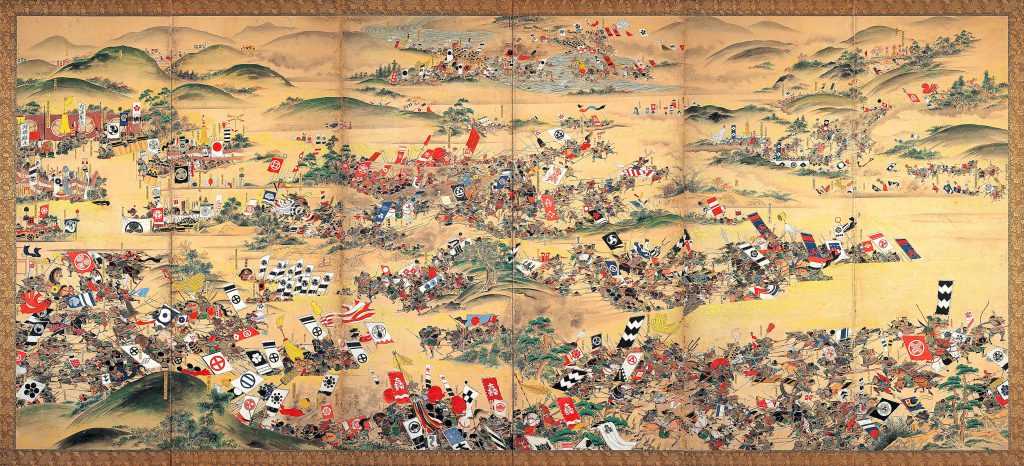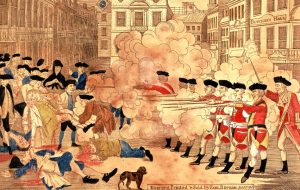The Battle of Sekigahara took place in Japan near the end of the Sengoku Jidai or The Warring States Period (1467-1615). These nearly 150 years were the most violent times in Japanese history, where warlords battled each other for land and power. Since this period lasted for so long, the way battles were fought had changed. The first battle of the Sengoku Jidai that happened in 1467, called the Onin War, was fought with bows and swords, but by the end of the era, battles were influenced by the introduction of European cannons and guns. The Onin War, which started it all, had lasted for ten years and was instigated by the Hosokawa and Yamana clans. At that time, the capital of Japan was Kyoto, which housed the Ashikaga Shogunate, and it was the Ashikaga that held authority over the country. In the city, both clans owned mansions and their rivalry took a turn for the worse. The two clans fought in the city, and others who were caught in the crossfire had to choose to side with one or the other to protect themselves. Soon the situation spiraled out of control and the shogunate was not able to quell the fighting. The Onin War caused a domino effect that started with the Hosokawa and Yamana clans, and year by year the whole country was at war.1
During the Sengoku Jidai, there were three great unifiers, the first being Oda Nobunaga, who conquered central Japan. He started making waves in 1560, when a powerful warlord attempted to take over Nobunaga’s territory. Severely outnumbered by the invading Imagawa clan, Nobunaga managed to take Imagawa Yoshimoto by surprise under the cover of a thunderstorm and killed him. This victory marked the beginning of Nobunaga’s conquest of central Japan and was now aided by fair weather clans who had supported Imagawa. Eight years later, in 1568, with the help of his ally Tokugawa Ieyasu, who was watching his back, Nobunaga started his march towards Kyoto to remove the shogun and put himself in power. Needless to say, this aggressive move was not well received by the other warlords, who felt threatened by Nobunaga taking control of Kyoto. Doubly so by Ieyasu moving from his castle in Okazaki to another more advantageously positioned Hamamatsu castle in 1570. The location of Hamamatsu castle was at the mouth of the Tenryugawa river, which starts in the territory owned by Nobunaga’s rival Takeda Shingen. The Takeda clan was another prominent force that should not be taken lightly. Takeda Shingen marched in the snow towards Hamamatsu castle and had forced Ieyasu’s forces back behind the walls. After the defeat, Ieyasu’s general Torii Mototada had ordered the gates to be closed. Ieyasu knew that that was what Shingen wanted, so he told Mototada to leave them open and light fires to guide the retreating troops back. Surprised by this, Shingen thought that the gates being left open was a trap, so he decided not to storm the castle and had his troops camp out in the cold. Making use of the terrain, Ieyasu had sent out 16 riflemen and 100 other foot soldiers at night to attack their camp. The Takeda were known for their horsemen, but in this case it was their downfall when the Tokugawa troops led the horsemen down to a ravine. Under the cover of darkness coupled with the snow, many of the horsemen could not stop in time and fell in, while the Tokugawa soldiers finished them off.2

Since Nobunaga’s conquest of Kyoto, things had been going well and he had become the most powerful man in Japan. In the summer of 1582, Nobunaga’s general Toyotomi Hideyoshi fought against the Mori clan on the west side of the country, while Tokugawa Ieyasu was fighting on the east side. Hideyoshi’s battle at Mori’s Takamatsu castle stagnated, and he was unable to break through the Mori defenses. In order to win, he decided to request reinforcements from Nobunaga. What Hideyoshi didn’t know was that his request came with a major consequence. Nobunaga had sent out his troops in advance under the command of another general by the name of Akechi Mitsuhide and he would catch up to them at Takamatsu castle. This had left Nobunaga unguarded, and at night Mitsuhide turned the army around with the intention of betraying Nobunaga. During the attack, Nobunaga was staying at Honnoji temple in Kyoto when Mitsuhide’s troops arrived and set the temple ablaze, knowing that he could not escape, Nobunaga took his own life and died in the fire.3
After the event, Mitsuhide declared himself the Shogun, and after hearing the news, Hideyoshi surrendered his assault and took his troops back to Kyoto. Surprised that Hideyoshi returned so quickly, Mitsuhide was caught off guard and had his troops position themselves on a hill by the Yodo river; but it was for naught. Hideyoshi had routed the enemy who had dispersed in all directions, and Mitsuhide died at the hands of a peasant gang.4 But Hideyoshi’s work was far from over; he could not be the shogun because he was not from a notable family; so he became the civil prime minister. Hideyoshi picked up where Nobunaga left off and became the second great unifier. And by 1591, he had control of the entire country. Seven years later, in 1598, Hideyoshi became ill and his heir was only five years old. Before he died, Hideyoshi held a meeting with five of the strongest warlords and made them swear to rule together along with five commissioners until his son was of age to take his father’s spot. The five warlords were Tokugawa Ieyasu, Maeda Toshiie, Uesugi Kagekatsu, Mori Terumoto, and Ukita Hideie. Hideyoshi had made Toshiie the guardian of his son along with Tokugawa Ieyasu. Then on September 15, 1598, Hideyoshi had succumbed to his illness.5
This was where the scheming and working in the shadows took place, because everyone knew that the country was not going to remain peaceful, now that Hideyoshi was dead. The first to start the scheming was Ishida Mitsunari, who was trying to decrease Tokugawa Ieyasu’s influence. After Ieyasu moved into the late Hideyoshi’s castle, Mitsunari went to Toshiie, who was the guardian of Hideyoshi’s son, to try and turn him against Ieyasu. Luckily for Ieyasu, Hosokawa Tadaoki was there to counteract Mitsunari’s scheming and convinced Toshiie and his son that it would be in his best interest to not mess with Ieyasu. Having his plan backfire, Mitsunari then chose to stage an assassination of Ieyasu, but that too failed when Ieyasu’s generals found out about it. They had decided to kill Mitsunari, and in a surprising turn of events, Mitsunari fled for his life and sought protection from Ieyasu. No one knows why Ieyasu granted Mitsunari protection, but his choice made the future tougher for himself.6

So, who was this Tokugawa Ieyasu? He held territory in the “breadbasket” of Japan, which made him a very wealthy and powerful man. Power was determined by how much food-bearing land someone controlled, and Ieyasu’s territory in the Kanto region provided him with 2.5 million koku. One koku is 180 liters of rice, which is enough to feed a man for one year. Coupled with being rich, Ieyasu had chosen strong allies; he was on Nobunaga’s side, while other clans perished while trying to oppose him; and he was smart enough to back Hideyoshi’s rule. After Maeda Toshiie died, Ieyasu became the guardian of Hideyoshi’s son Hideyori, and he moved into the Osaka castle where Hideyoshi was staying. This angered the commissioners and warlords, including Mitsunari. But during that time Ieyasu also dealt with the troublesome Uesugi clan that was to the east of Japan. Mitsunari saw this opportunity, and himself and a group of others issued a complaint that Ieyasu believed was a declaration of war.7
Since the time of Hideyoshi’s death, everyone was forming alliances, and Ieyasu was no different. A rule that he broke being one of the rulers was that he could not marry off children for diplomatic reasons. But that was one of the ways he had formed alliances that allowed him to form the Eastern Army. The Eastern Army, led by Tokugawa Ieyasu, were the separatists who did not want to wait for Hideyori’s son to rule. When the Eastern Army formed, Mitsunari then formed the Western Army, who were the loyalists. The whole country was now divided by whom they supported. Ieyasu had started the campaign in the east and split his army; he sent his son to attack the Sanda clan, while he led 30,000 men towards the west where Mitsunari was. Getting closer, Ieyasu ordered his subordinates to take Gifu and Kiyosu castles, which were on two important roads, while Mitsunari was taking Fushimi castle, whose defenses were strong and held up his army. After taking Fushimi castle, he moved on to Ogaki castle, where he met with the Eastern Army and had a skirmish in Akasaka. Nothing came out of it, but at night a couple of Mitsunari’s generals had posed a night battle and believed they had the upper hand. Mitsunari’s strategist scoffed at the idea, calling it weak, and Mitsunari called for a retreat to a more strategic location at a village in a valley called Sekigahara.8
The year was 1600, and both armies had arrived at around 1:00 am, but a torrential rain was coming down and by the time both had set up their positions, it was 4:30 am. Mitsunari’s plan was to draw the Eastern forces into the valley and surround them; two sides of the valley were blocked my mountains, which made running away difficult. The rain had let up and had turned into a dense fog. By 8:00 am, the fog had lifted and both armies were surprised by how close they were to one another. Both armies had around 80,000 troops, and the Eastern Army kicked off the battle with mounted cavalry led by Ii Naomasa and Fukushima Masanori straight to Ukita Hideie’s positon. The push had shocked the Western Army, and 20,000 more Eastern forces charged towards Mitsunari’s encampment. Mitsunari then had cannons fire upon the west to be used as a fear tactic, which succeeded, and forced his enemies back. Two hours had passed and only 35,000 of Mitsunari’s alliance had joined the battle. The Shimazu clan, 3000 in total, had not moved from their position. Angered by this, Mitsunari personally went to their camp and asked them to join the battle. Shimazu did not respond positively, which may have been because his advice about the night attack prior to the battle had been scoffed at.9

Another hour passed and the battle went back and forth with no clear winning side. Mitsunari, looking from a vantage point at Mount Sasao, had called for all of his forces to make a final push. Mitsunari had an ace up his sleeve; 15,000 men led by Kobayakawa Hideaki had been waiting on Mount Matsuo for Mitsunari’s call to charge at the Eastern Army. But before the battle, Hideaki had sent a letter to Ieyasu that told him that he would switch sides to the east. When Mitsunari signaled for Hideaki, he did not respond. At the same time, four other divisions and Kikawa Hiorie were ordered to attack, but they too defied Mitsunari’s orders. Hideaki having been given a push by Ieyasu and charged towards Mitsunari’s forces, and the Shimazu clan then fled from the fight. Overwhelmed, the remaining Western Army had lost and Mitsunari was captured and executed in Kyoto.10 Tokugawa Ieyasu was now the third great unifier, which led the country to 200 years of peace. His descendants had feared that foreign influence would thrust the country back into another age of war, so they turned away all foreigners, with only a few exceptions for trade.11
- Stephen R. Turnbull, War in Japan 1467-1615, Essential Histories 46 (Oxford: Osprey Publishing, 2002), 8-14. ↵
- Stephen R. Turnbull, War in Japan 1467-1615 Essential Histories 46 (Oxford: Osprey Publishing, 2002), 42-49. ↵
- Stephen R. Turnbull, War in Japan 1467-1615 Essential Histories 46 (Oxford: Osprey Publishing, 2002), 52-53. ↵
- Stephen R. Turnbull, War in Japan 1467-1615 Essential Histories 46 (Oxford: Osprey Publishing, 2002), 54. ↵
- Anthony J. Bryant, Sekigahara 1600: The Final Struggle for Power, Osprey Military Campaign Series 40 (London: Osprey, 1995), 7-8. ↵
- Anthony J. Bryant, Sekigahara 1600: The Final Struggle for Power Osprey Military Campaign Series 40 (London: Osprey, 1995), 9, 10, 12. ↵
- Anthony J. Bryant, Sekigahara 1600: The Final Struggle for Power Osprey Military Campaign Series 40 (London: Osprey, 1995), 8,12,13,14. ↵
- Anthony J. Bryant, Sekigahara 1600: The Final Struggle for Power Osprey Military Campaign Series 40 (London: Osprey, 1995), 12,13,38,39,41,49. ↵
- Anthony J. Bryant, Sekigahara 1600: The Final Struggle for Power. Osprey Military Campaign Series 40 (London: Osprey, 1995), 25,51-65. ↵
- Anthony J. Bryant, Sekigahara 1600: The Final Struggle for Power Osprey Military Campaign Series 40 (London: Osprey, 1995), 47,66-80. ↵
- Stephen R. Turnbull, War in Japan 1467-1615 Essential Histories 46 (Oxford: Osprey Publishing, 2002.), 87. ↵



85 comments
Lucia Rogel
I enjoyed reading this article because of the overall richness of the sentences and the use of images. The sentences sustain rich and sufficient information that forms strong paragraphs throughout the article. Not only that, but the images coordinate with the article’s content and the information provided in the paragraphs before each picture. As a visual learner, this makes it simpler to retain information and connect different ideas together. For instance, reading the significance of wealth in Japan during this period justified why the Tokugawa Ieyasu was being “hunted down” by the other warlords. There is also a possible cause-and-effect situation that transitions from explaining Tokugawa’s power to the imbalance in army size when comparing Tokugawa’s and Mitsunari’s troops and how that led to the downfall of Mitsunari.
Jose Maria Gallegos Cebreros
First of all congrats on your great article, I enjoyed reading it a lot. You provide information that i know a lot of people don’t know about. The characteristic that I enjoyed more about your article was the imagery that you used, starting with the image at the top that gives you a good introduction without even reading and wrapping up the article with the maps you used.
Alanna Hernandez
The west may have a a brutal history but it’s nothing compared to what Japan has seen in terms of war. Too much is can be overlooked, especially the warlords and in Japan to the point where they sound more like fables. Putting the iconic portrait of Tokugawa Ieyasu backs that!
Eugenio Gonzalez
The article was very informative. It was interesting to find out that Japan’s capital used to be Kyoto. Reading the article made me interested in the policy of Ieyasu and his descendants by turning away all foreigners but making a few exceptions for trading. The maps were helpful because they provided a better understanding of the article. Overall, it was a great article and did an excellent job describing the war and alliances to readers.
Sofia Perez
I do not know much about Japanese history, so this was interesting. Reading this article was a little difficult as there is a lot going on and trying to remember who was who. From the article, my favorite part was reading about Hideyoshi right before he was going to die. He called upon the 5 warlords to take care of his son until he becomes of age to take his father’s spot.
Lauren Deleon
Great job! This topic had so many different names to keep track of, it is obvious that you did a lot of really thorough research to get the final product. I have heard about Japan’s violent history but have never read much about the details so this was very interesting. I actually have been to the Hamamatsu castle in Japan so it was very cool to see it mentioned here.
Jaedon E
Great article! I love the descriptive pictures that were used. Moreover what I did find interesting was the map of Japan. Seeing all of those different colors, knowing all of the different kingdoms. Reading about how the Battle of Sekigahara lasted for 150 years and was the most violent war in Japan is fascinating.
Luke Rodriguez
What a fantastic article very informative, and I learned more about Japanese history, which I know little about. Before reading this, I knew very little about ancient Japan’s history, which is something that hooked me to this article and learning more about this subject. The map included in the article helped me understand more about the country in the province time.
Nicholas Quintero
This article was very interesting, and I enjoyed learning about the nuances of the power conflict during this time period with the warlords. It made good use of the pictures to highlight the landscape that this conflict was taking place too. I also appreciated how the articled flowed and presented its information without becoming over bearing.
Paula Ferradas Hiraoka
This was an amazing article about Japan. After reading it, I can tell that the research was on point and made me learn some of the Japanese culture I didn’t knew. Considering that this is a very broad topic, I love how you manage to summarize all the information and came with this wonderful article. The pictures were also very pleasing to the eye and complemented the text. Amazing work and what an incredible job!